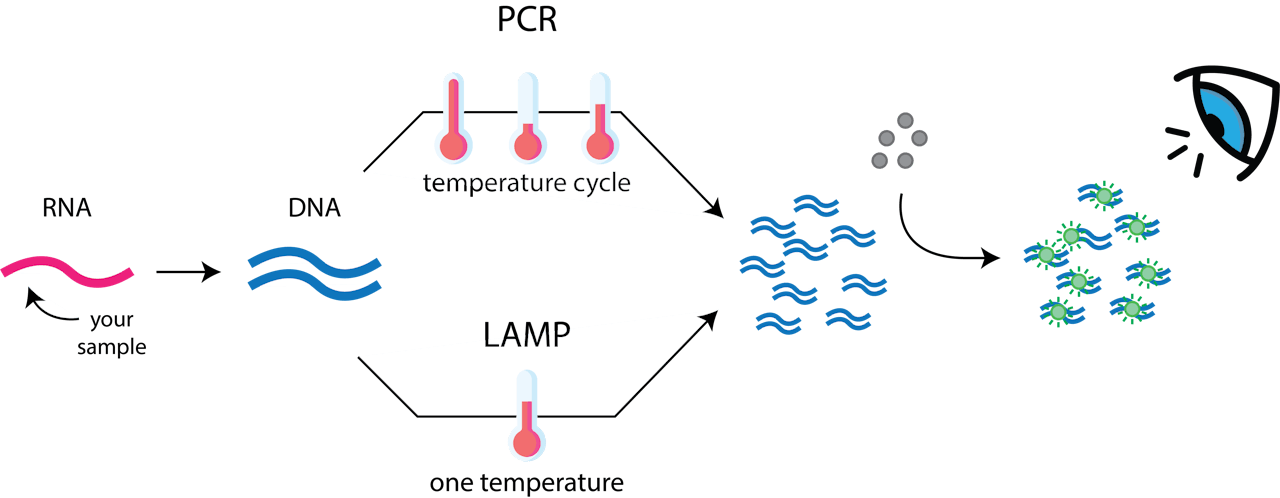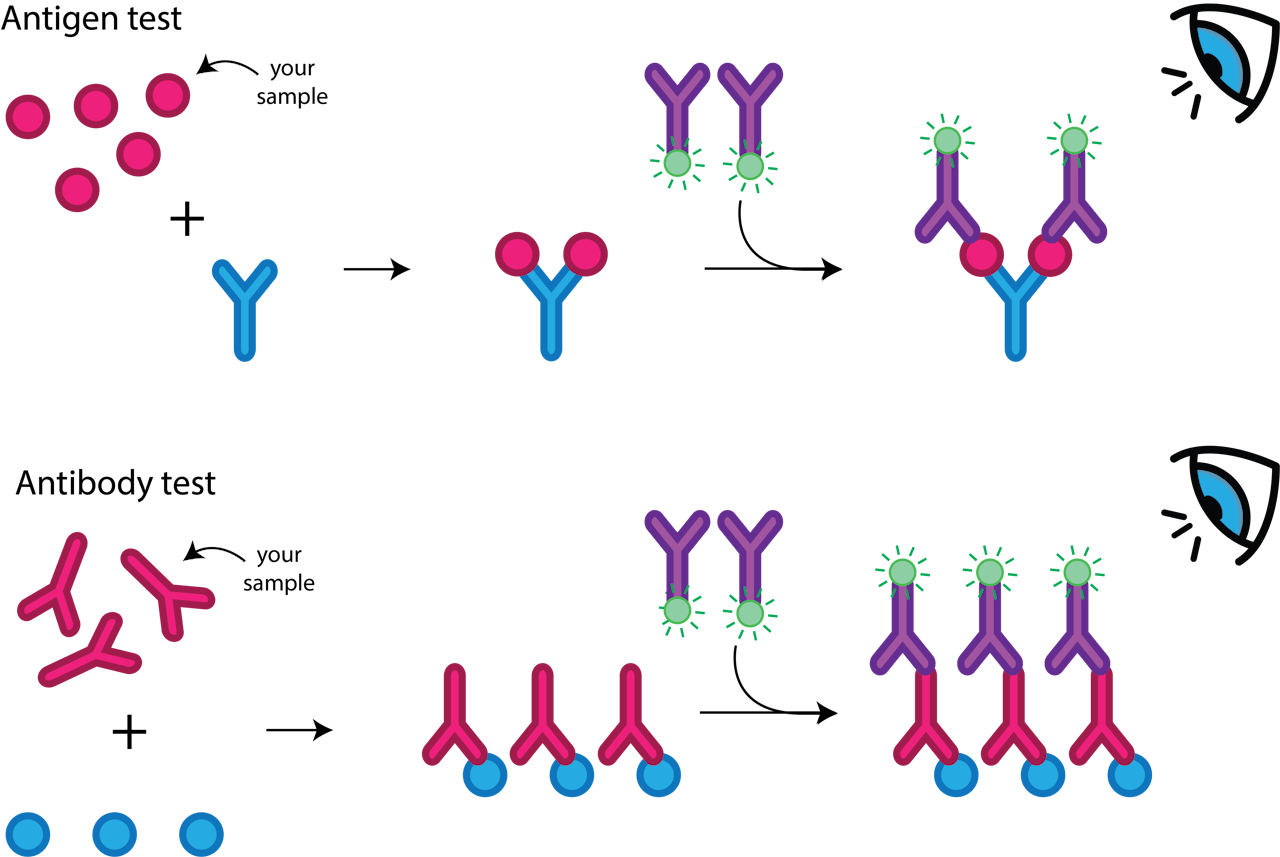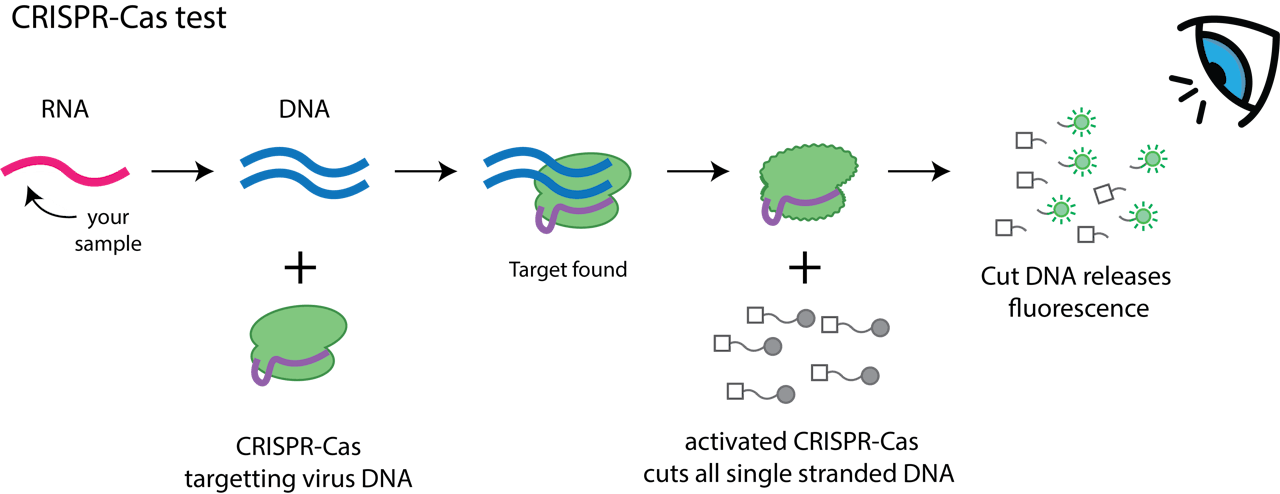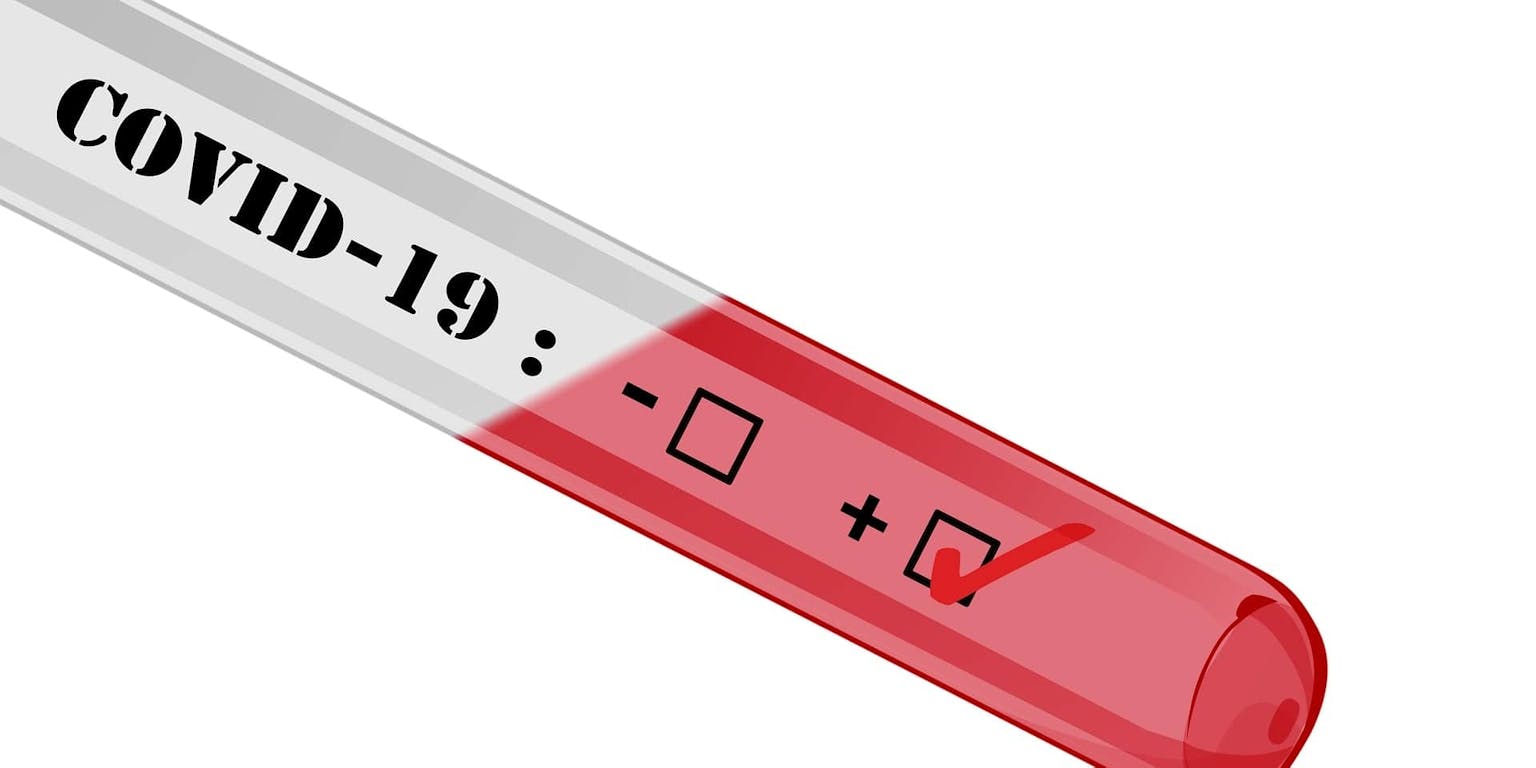Testen voor het coronavirus is tegenwoordig heel normaal. Jij of iemand in je omgeving heeft waarschijnlijk al eens een Coronatest gedaan. Kun je ook testen met hulp van CRISPR-Cas?
Als je loopt te snotteren, hoest of andere symptomen hebt die met corona te maken hebben, wil je graag weten of je het virus onder de leden hebt. Je meldt je aan voor een afspraak, gaat naar de testlocatie, en daar steken ze een wattenstaafje in je keel en neus. Volgende dag hoor je of je positief of negatief bent getest voor het coronavirus. Maar wat gebeurde er tussendoor met de test en je uitslag? En is CRISPR-Cas ook bruikbaar voor het testen van het coronavirus?
We horen de hele tijd op het nieuws dat testen belangrijk is om de verspreiding van het virus tegen te gaan. Er zijn veel verschillende soorten tests. Met behulp van een wattenstaafje haal je monsters uit keel en neus die gebruikt worden in een PCR, LAMP of antigeentest. Met een bloedmonster doe je een serologische test, om de aanwezigheid van antistoffen tegen het virus aan te tonen.

Verschillende coronatesten
Wen Wu voor NEMO KennislinkPCR en LAMP
PCR wordt momenteel beschouwd als de ‘gouden standaard’ voor testen, aangezien het de meest betrouwbare is. Maar helaas is het ook de langzaamste methode. PCR werkt door eerst het virus-RNA om te zetten in DNA. Vervolgens wordt het virus-DNA velen malen gekopieerd totdat er heel veel virus-DNA is. Als er veel DNA is, kunnen we dat visualiseren met een kleurstof die bindt aan DNA. Als je een kleur ziet, ben je positief voor COVID-19.

PCR en LAMP-test
Wen Wu voor NEMO KennislinkDe PCR-methode is traag omdat er meerdere cycli van verschillende temperaturen nodig zijn om het virus-DNA te kopiëren. LAMP, een andere methode, werkt op een vergelijkbare manier, maar het is sneller omdat het maar één constante temperatuur nodig heeft om dezelfde resultaten te bereiken. Het probleem met LAMP is dat het soms ander niet-virus-DNA kan kopiëren, waardoor valse positieven worden gecreëerd.
Antigeentest en antilichaamtest
Andere soorten sneltesten zijn antigeen- en antilichaamtesten. De antigeentest detecteert viruseiwitten in je lichaam en de antilichaamtest detecteert het antilichaam dat je lichaam heeft geproduceerd tegen het virus (zie figuur beneden).

Antigeen- en Antilichamentest
Wen Wu voor NEMO KennislinkBeide werken op een vergelijkbare manier. Het antigeen bindt zich aan een antilichaam (blauw antilichaam) om het ‘vast te houden’ en vervolgens bindt een ander antilichaam dat is verbonden met een gekleurde kleurstof (paars antilichaam) zich aan het antigeen. Als er een kleur in je monster zit, betekent dat je positief bent (geweest) voor COVID-19. Wat betreft de antilichaamtest, antilichamen uit je bloed binden zich aan het antigeen (blauw antilichaam) om het vast te houden. Dan bindt een andere antilichaam (paars antilichaam) zich aan jouw antilichaam en geeft een kleur af. Als je een kleur ziet, betekent dit dat je lichaam antistoffen tegen het virus heeft gemaakt.
Lees hier en hier meer voor sneltesten.
CRIPSR-Cas de volgende generatie sneltesten
De PCR-test is traag, de LAMP kan een hoger foutenpercentage hebben, de antigeentest heeft voldoende antigeen nodig om een signaal af te geven, wat betekent dat je aan het begin van de infectie negatief kan zijn en de antilichaamtest vertelt alleen dat je het virus eerder hebt gehad. Momenteel is er geen test die gevoelig, nauwkeurig en snel is. Wellicht is CRISPR-Cas de oplossing.

CRISPR-Cas-test
Wen Wu voor NEMO KennislinkCRISPR-Cas-eiwitten herkennen specifieke DNA-sequenties, in dit geval het virus-DNA. Eenmaal gevonden, hebben sommige type CRISPR-Cas-eiwitten het vermogen om gek te worden als ze het virus vinden. Dan beginnen ze andere DNA in zijn omgeving te knippen. Het lijkt wel een beetje op de Hulk die boos wordt en alles kapot maakt . Als we die HULK-smash-eigenschap van deze CRISPR-Cas-eiwitten gebruiken, kunnen we ervoor zorgen dat er een kleur vrijkomt wanneer de CRISPR-Cas-eiwitten ander DNA gaan knippen. Na ongeveer 20 minuten is die kleur detecteerbaar. Dit maakt de diagnose van CRISPR-Cas gevoelig, nauwkeurig en snel. Lees hier meer over CRISPR-Cas diagnostiek in een vorig artikel
Momenteel zijn er drie verschillende bedrijven die CRISPR-Cas-diagnostiek ontwikkelen. Waarvan elk bedrijf met een andere soort CRISPR-Cas-eiwit werkt. De eiwitten verschillen in hun mechanisme, maar volgen ongeveer hetzelfde concept van het afbreken van DNA om een gekleurd signaal af te geven in aanwezigheid van het virus. Twee bedrijven zitten in de Verenigde Staten (Mammoth Biosciences en Sherlock Biosciences) en één is een nieuwe start-up in Nederland bij Wageningen Universiteit (Scope Biosciences).
CRISPR-Cas-diagnostiek is een nieuwe en veelbelovende technologie voor het detecteren van virussen en kan in de toekomst worden gebruikt op een (commerciële) testlocatie in Nederland. De technologie ligt klaar, nu nog de regulatie ervan regelen. Hopelijk kunnen we in de zomer van 2021 met behulp van de Hulk-eigenschappen van CRISPR-Cas sneller (commercieel) testen op het coronavirus, zodat we het virus vlugger kunnen smashen.
Blijf voorlopig gezond, blijf COVID-19 negatief en blijf testen, testen, testen.
Test, test, test. But which one? also with CRISPR-Cas?
Nowadays testing for the coronavirus is a very normal thing. You yourself or someone you know has a done a Corona test before. Can CRISPR-Cas also be used for testing coronavirus?
When you start sneezing, coughing or show any other symptomes related to corona you’d probably want to know asap if you have the virus or not. You sign up for an appointment, you go the test location, they put a stick through your throat and nose and you get the results the following day to see if you are positive or negative for the coronavirus. However, what happened in between and can CRISPR-Cas also be used for testing coronavirus?

Different corona tests
Wen Wu voor NEMO KennislinkWe hear it all the time on the news that testing is important to reduce the spread of the virus. There are many different types of tests. Using a swab sample from you throat and nose you can do a PCR, LAMP and Antigen test. From your blood you can do a serological test, to test for the presence of antibodies against the virus.
PCR and LAMP
PCR is currently considered the “golden standard” for testing, as it is the most reliable but unfortunately the slowest method. PCR works first by converting the virus RNA to DNA and then makes a lot of copies of the virus DNA. When there is a lot of DNA, we can visualize it with color dye that binds to DNA. If you see a color, you are positive for COVID-19.

PCR en LAMP-test
Wen Wu voor NEMO KennislinkThe PCR method is slow because it needs to go to several cycles of different temperatures to be able to copy the virus DNA. LAMP on the other hand works in a similar way, but it is faster because it only needs one constant temperature to achieve the same results. The problem with LAMP is that it can sometimes amplifies non-specifically, creating false positives.
Antigen and Antibody test
Other quick Corona tests are antigen and antibody tests. The antigen test detects virus proteins in your body and the antibody test detects the antibody that you have created against the virus in your blood (see figure below). Both works in similar ways. The antigen binds to an antibody (blue antibody) to “hold it in place” and then another antibody connected with a colored dye (purple antibody) binds to the antigen.

Antigen,- and Antibody test
Wen Wu voor NEMO KennislinkIf you see a color in your sample, it means the antigen is present in the sample. As for the antibody test, antibodies from your blood binds to the antigen (blue antibody) to hold it in place. Then again another antibody (purple antibody) that can recognize your antibody will bind to and emit a color. If you see a color, it means you body has created antibodies against the virus.
You read more about these fast testing methods here and here.
CRIPSR-Cas the next generation of fast testing
The PCR test is slow, the LAMP can have a higher error rate, the antigen test needs enough antigen to give a signal meaning you might be negative at the beginning of the infection and the antibody test only tells you have you have had the virus before. Currently there is no test that is sensitive, precise and fast. CRISPR-Cas diagnostics might be the test that we are looking for. CRISPR-Cas proteins can recognize and find specific DNA sequences, in this case the virus DNA.

CRISPR-Cas-test
Wen Wu voor NEMO KennislinkOnce found, some CRISPR-Cas proteins have this ability to go crazy after finding the virus and starts cutting other DNA in its surroundings. Like how when the HULK gets angry and starts HULK smashing everything. Well using this HULK smash ability of these CRISPR-Cas proteins, we can make it that a color gets released when the CRISPR-Cas proteins start cutting other DNA which is detectable after about 20 minutes. This makes CRISPR-Cas diagnostics sensitive, precise and fast. Read more on CRISPR-Cas diagnostics in a previous article here
/a>
There are currently three different companies developing CRISPR-Cas diagnostics. Each company works with a different kind of CRISPR-Cas protein for their detection tool. The proteins differ slightly in their mechanism but all follow the same concept of degrading DNA to release a colored signal when the virus is present. Two companies are in the U.S.A. (Mammoth Biosciences and Sherlock Biosciences ) and one is a new start-up in the Netherlands at Wageningen University (Scope Biosciences ). CRISPR-Cas diagnostics is new and promising technology for detecting viruses and might one day be used in a (commercial) test location near you.
For now, stay healthy, stay COVID-19 negative and test test test.

